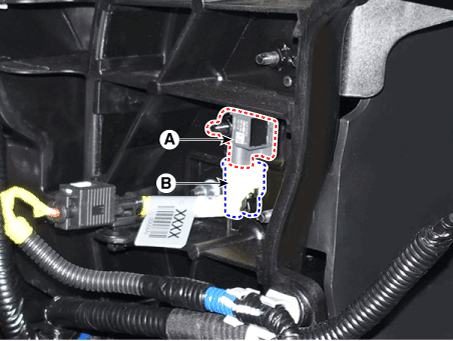Hyundai Palisade: SRSCM / Front Impact Sensor (FIS)
Components and components location
| Components |

| 1. Front impact sensor (FIS) |
2. Front impact sensor (FIS) |
Description and operation
| Description |
The front impact sensor (FIS) is installed in the Front End Module (FEM). They
are remote sensors that detect acceleration due to a collision at its mounting
location. The primary purpose of the Front Impact Sensor (FIS) is to provide
an indication of a collision. The Front Impact Sensor (FIS) sends acceleration
data to the SRSCM.
Repair procedures
| Removal |
|
| 1. |
Disconnect the battery negative cable, and wait for at least three minutes
before beginning work.
|
| 2. |
Disconnect the front impact sensor connector (B) and then remove the
front impact sensor (A) after loosening the mounting bolt.
|
| Installation |
|
| 1. |
Install a new front impact sensor.
|
| 2. |
Tighten the front impact sensor mounting nut.
|
| 3. |
Connect the front impact sensor connector.
|
| 4. |
Install the radiator assembly.
|
| 5. |
Reconnect the battery negative cable.
|
| 6. |
After installing the front impact sensor, confirm proper system operation
:
Turn the ignition switch ON; the SRS indicator light should turn on
for about six seconds and then go off.
|
 SRS Control Module (SRSCM)
SRS Control Module (SRSCM)
Components and components location
Components
[LH]
1. Supplemental Restraint System
Control Module (SRSCM)
Description and operation
Description
The primary purpose of the SRSCM (Supplemental Restraints System Control Module)
is to discriminate between an event that warrants restraint system deployment
and an event that does not...
 Side Impact Sensor (SIS)
Side Impact Sensor (SIS)
Components and components location
Components
1. Gravity Side Impact Sensor
[G-SIS (B-Pillar)]
2. Gravity Side Impact Sensor [G-SIS (C-Pillar)]
3...
Other information:
Hyundai Palisade (LX2) 2020-2025 Service Manual: Spark Plug
Specifications Specification Item Specification Type SILZKR7E11 Gap 1.0 - 1.1 mm (0.0394 - 0.0433 in.) Insulation resistance (MΩ) 10 or more Description and operation Description A spark plug is a device for delivering electric current from an ignition system to the combustion chamber of a spark-ignition engine to ignite the compressed fuel/air mixture therein by means of an electric spark, while containing combustion pressure within the engine...
Hyundai Palisade (LX2) 2020-2025 Owner's Manual: Immobilizer Indicator Light
Immobilizer Indicator Light (without smart key) This indicator light illuminates: • When the vehicle detects the immobilizer in the key with the ignition switch in the ON position. - At this time, you can start the engine. - The indicator light goes off after starting the engine...
Categories
- Manuals Home
- 1st Generation Palisade Owners Manual
- 1st Generation Palisade Service Manual
- Check Tire Pressure
- Theft-alarm system
- Removing and Storing the Spare Tire
- New on site
- Most important about car
Rear Seats
Rear seat adjustment

Forward and rearward (2nd row seat)
To move the seat forward or rearward:
1. Pull the seat slide adjustment lever up and hold it.
2. Slide the seat to the position you desire.
Copyright © 2025 www.hpalisadelx.com



